Solar Flares
You may have seen the "northern lights" in the fall of 2003, even if you live as far south as Texas or Italy. This energy in the sky originated in record-setting solar flares and coronal mass ejections triggered by the sudden release of magnetic energy near sunspots. The images show the flares and sunspots on October 28, 2003. These flares can equal one-tenth of the sun's total output, or, to put it another way, they can be as powerful as millions of large hydrogen bombs going off at once. The emitted energy is spread across the electromagnetic spectrum, from radio waves through gamma rays. The October 28 flare was followed by a record-breaker on November 4, which produced such intense radiation that the x-ray detectors on National Oceanic and Atmospheric Administration's satellites went off-scale for eleven minutes.
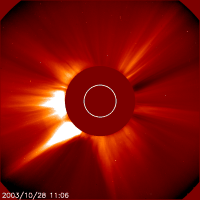
Movie of the coronal mass ejection (CME) on October 28, 2003. A disk blocks the light of the sun itself to make the CME visible. The “snow” at the end of movie is noise from the blast of charged particles from the sun. (image/movie courtesy of NASA)
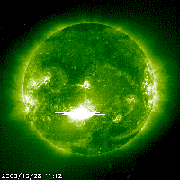
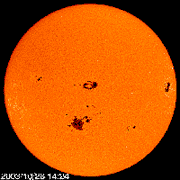
The flares of October 28, in extreme ultraviolet light, along with the sunspots on that date. Compare the positions of flares and sunspots. (images courtesy of NASA).
In coronal mass ejections (CMEs), mentioned above, the sun belches forth vast amounts of matter—up to 10 billion tons of plasma (see Plasma Power). CMEs are often associated with solar flares, and the one that followed the November 4 flare is shown in the movie.
Even in its quiet state, the sun emits a constant stream of plasma called the solar wind, which fills space in the solar system. The solar wind and the CME—two plasmas—interact. The leading edge of the CME produces damaging high energy particles as it moves through the solar wind, even far from the sun. The Mars Odyssey spacecraft, more than halfway to its destination, was briefly disabled by these charged particles from the October 28 flare, and a radiation-monitoring instrument on the satellite has not recovered yet. Moreover, had astronauts been on the surface of Mars at this time, they would have been in great danger from the heavy dose of particle radiation.
The CME can also disturb Earth's magnetic field and produce damaging space weather effects, which can include communications problems and disruptions of electric power (see Space Weather). In addition, the high energy charged particles produced by the CME can be dangerous to spacecraft and astronauts. Two Japanese satellites were crippled by the October 28 flare, and numerous others had to be powered down into “safe mode” until the volley of particles had passed. On the other hand, Earth's magnetic field protects us by deflecting incoming charged particles, trapping them in orbits that extend along Earth's magnetic field lines, far above the surface (see drawing).
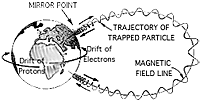
Charged particles trapped along a line of Earth's magnetic field. Note that the particle spirals in, reaches a minimum altitude, and is then reflected in the opposite direction. (image courtesy of NASA)
Research
As radiation and charged particles from the fall 2003 solar flares buffeted communications satellites, a spacecraft called Cassini (see photo) was safely speeding towards a 2004 rendezvous with Saturn. Cassini was designed to make a variety of measurements in the near-Saturn environment, including radio emissions, so it was well equipped to observe radio bursts that were produced by these two solar flares.
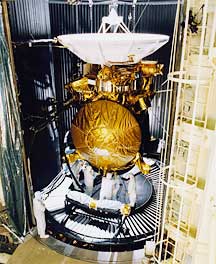
The Cassini spacecraft (image courtesy of NASA).
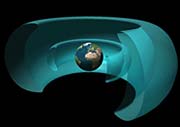
The Van Allen radiation belts, with Earth in the center. The belts consist of charged particles spiraling around the lines of Earth's magnetic field, bouncing repeatedly from pole to pole and back again. An electron in the inner belt can make this round trip in about one second. (The source of this material is Windows to the Universe, at http://www.windows.ucar.edu/ at the University Corporation for Atmospheric Research (UCAR). ©1995-1999, 2000 The Regents of the University of Michigan; ©2000-01 University Corporation for Atmospheric Research. All Rights Reserved.)
These radio bursts were not part of the flare itself, but rather were generated when a beam of electrons ejected by the flare interacted with the solar wind. The beam excited oscillations in the solar wind at the “electron plasma frequency,” which decreases rapidly with increasing distance from the sun. Once excited, these electrons emit radio waves at that same frequency, and these were the signals that Cassini observed.
Part of the Cassini data for the October 28 flare is shown in the graph, which plots frequency vs. time. The labels show that the data covered roughly the frequency range of AM radio. The leading edge of the burst arrived 69 minutes after the solar flare, since that was the radio travel-time from the sun to the spacecraft, then located about 8.7 A.U. from the sun (A.U. is Astronomical Unit, the distance from Earth to the sun, about 8 light-minutes). In the graph, notice how the frequency of the radio waves diminished with time after the burst arrived. As the electron beam propagated farther from the sun, it excited radio waves with a lower frequency, corresponding to the decrease of frequency with time that Cassini observed.
The data from this radio burst have been turned into sound by electronic manipulation. To hear this sound, click and then click on each of the colored graphs you will see. Notice how the drop in pitch of the sound corresponds to the rapid decrease of the frequency shown in the graph.
The principal investigator of the radio wave instrument on the Cassini Project is Don Gurnett, James Van Allen Professor of Physics at the University of Iowa, which has long been a center of space research. At Iowa, in 1958, Van Allen built the detector that found the first evidence for the regions of energetic electrons around Earth, known as the Van Allen radiation belts (see drawing below). In his own career at Iowa, Gurnett has contributed to many probes, including serving as principal investigator for the plasma wave investigation on Galileo, whose mission included observations of the magnetic field of Jupiter and the plasma that surrounds it, and principal investigator for the plasma wave instrument on the two Voyager spacecraft, which flew by Jupiter, Saturn, Uranus, and Neptune, and are now proceeding outward into interstellar space.
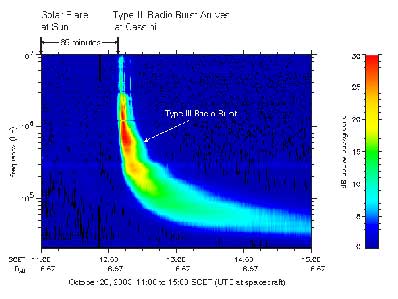
A plot of radio wave frequency vs. time for the October 28 solar flare, as observed by the Cassini spacecraft on its way to Saturn. The y-axis shows the frequency of the radio waves, which is approximately in the AM band. The x-axis shows time. (image courtesy of Ron Gurnett, University of Iowa)
Links
SpaceWeather.com
- Information about the Sun-Earth Environment (plus archives)
NASA
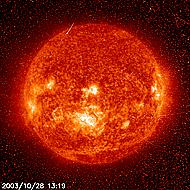
Another view of the powerful solar flare of October 28, 2003, again in the extreme ultraviolet. The glitter is noise in the detector from a blast of charged particles associated with the flare.
(image courtesy of NASA)
University of Iowa
James Van Allen














